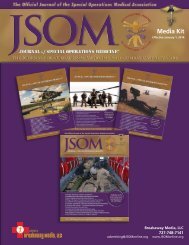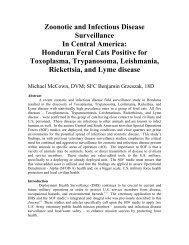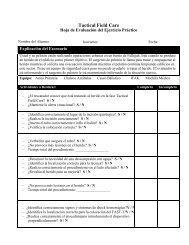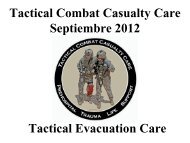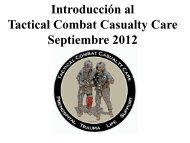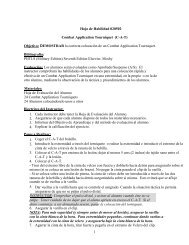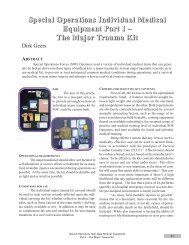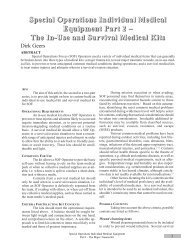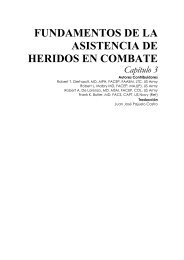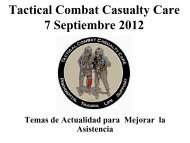Risk G. Hetzler M. Damage Control Resuscitation for the Special ...
Risk G. Hetzler M. Damage Control Resuscitation for the Special ...
Risk G. Hetzler M. Damage Control Resuscitation for the Special ...
Create successful ePaper yourself
Turn your PDF publications into a flip-book with our unique Google optimized e-Paper software.
of patients become coagulopathic much earlier <strong>for</strong> reasons<br />
that are at present not well delineated. That fact,<br />
coupled with <strong>the</strong> hemorrhage due to penetrating trauma<br />
may lead to a disproportionate loss of clotting factors,<br />
inactivation of normal coagulation due to acidosis and<br />
hypo<strong>the</strong>rmia, and inactivity of factors due to storage in<br />
banked blood and blood components. Consequently,<br />
in non-compressible hemorrhage on <strong>the</strong> battlefield, in<br />
an o<strong>the</strong>rwise young and healthy population, <strong>the</strong>re may<br />
be a role <strong>for</strong> early augmentation of <strong>the</strong> coagulation cascade.<br />
As previously noted, <strong>the</strong> proteolytic enzymes of<br />
<strong>the</strong> coagulation cascade function poorly at pH below<br />
7.2. Acidosis slows <strong>the</strong> rate of thrombin generation,<br />
while hypo<strong>the</strong>rmia delays <strong>the</strong> onset of thrombin generation.<br />
Biologically plausible arguments can be made<br />
<strong>for</strong> optimizing and augmenting <strong>the</strong> coagulation pathways<br />
and processes be<strong>for</strong>e significant hemorrhage occurs<br />
and shock develops as will be discussed.<br />
While we have <strong>for</strong> <strong>the</strong> most part solved <strong>the</strong><br />
challenge of extremity injury with <strong>the</strong> use of tourniquets,<br />
pressure, and wound packing, <strong>the</strong> developments<br />
of new types of hemostatic agents in <strong>the</strong> <strong>for</strong>m of a pad,<br />
packing sponge, or gel have provided adjuncts <strong>for</strong><br />
compressible and accessible wounds. The current challenge<br />
in <strong>the</strong> field <strong>for</strong> <strong>the</strong> medic is <strong>the</strong> non-compressible<br />
and non-accessible wounds, primarily in <strong>the</strong><br />
abdomen and pelvis in <strong>the</strong> absence of immediate surgical<br />
assets. Because of this, <strong>the</strong> use of non-surgical<br />
solutions needs to be aggressively considered. This<br />
would include <strong>the</strong> use of Factor VIIa, along with adjuncts<br />
such as calcium and sodium bicarbonate to optimize<br />
<strong>the</strong> biological activity of this potentially<br />
lifesaving modality. Factor VIIa works by activating<br />
through thrombin and various feedback loops both <strong>the</strong><br />
intrinsic and extrinsic coagulation pathways. The desired<br />
endpoint is assistance in <strong>the</strong> <strong>for</strong>mation of a thrombus<br />
at <strong>the</strong> site of injury in an o<strong>the</strong>rwise inaccessible<br />
location such as solid organs (liver, spleen, and kidney),<br />
large vessels, and pelvic structures. This might<br />
be thought of as mobilizing a damage control party to<br />
<strong>the</strong> site of injury in our ship analogy. Because of <strong>the</strong><br />
time involved, this must be considered <strong>for</strong> administration<br />
relatively early if severe hemorrhage is suspected.<br />
Delays awaiting conclusive evidence of Class III/IV<br />
shock may prove insurmountable. Interestingly, <strong>the</strong>re<br />
is some evidence that thrombus created with rVIIa administration<br />
may be more resistant to lysis and breakdown<br />
with reperfusion.<br />
Correcting coagulapathies will also be assisted<br />
by administering <strong>the</strong> proper blood products, and although<br />
FWB and FFP are specifically advocated in this<br />
article due to <strong>the</strong>ir natural contributions, <strong>the</strong>y will be<br />
addressed in Part Two, complete with all o<strong>the</strong>r fluid<br />
choices. In addition to resuscitation, prolonged care<br />
requires an exceptional skill set. Tracheotomies, fasciotomies,<br />
blood transfusions, anes<strong>the</strong>sia, and primary<br />
and delayed closure, all play an important role here.<br />
These are advanced skills and as such require proper<br />
sustainment. Nursing skills also have a huge importance<br />
in critical care and without <strong>the</strong>m none of <strong>the</strong><br />
above would be successful. Competence in aseptic<br />
technique, antibiotic <strong>the</strong>rapy, labs <strong>for</strong> <strong>the</strong> monitoring<br />
of endpoints, input and output, and basic nursing care<br />
including patient hygiene need to be appreciated.<br />
O<strong>the</strong>r concerns requiring attention are pre and post surgical<br />
skills, wound care, nutrition, rehabilitation, and<br />
even logistical needs. This skill set is now rarely exercised,<br />
except in <strong>the</strong> schoolhouse during records and<br />
reports, but is essential in <strong>the</strong> austere scenario.<br />
The authors hope that Part One provides a<br />
foundation in general knowledge of DCR <strong>for</strong> <strong>the</strong> SF<br />
medic; Part Two will identify options <strong>for</strong> measuring<br />
shock and recommend relative endpoints to serve as<br />
goals in resuscitation. Additionally we will propose<br />
not only <strong>the</strong> special equipment required, but <strong>the</strong> minimal<br />
equipment needed in care, and identify <strong>the</strong> critical<br />
care and nursing skills required to support DCR in our<br />
environment.<br />
REFERENCES<br />
1. BG Yeheskel Levy. (2007). Lecture. Advanced Technology<br />
Applications <strong>for</strong> Combat Casualty Care Conference.<br />
2. Holcomb J. (2007). <strong>Damage</strong> control surgery. Journal of<br />
Trauma; 62:S36-S37.<br />
3. Blackbourne L, McMullin N, Eastridge B, Baskin T, Holcomb<br />
J. (2007). Aggressive proactive combat damage<br />
control surgery. AMEDD Journal; January-March.<br />
4. Kaplan L, Bailey H. (2007). Ongoing resuscitation endpoints<br />
and strategies; Trauma;Emergency <strong>Resuscitation</strong> Vol<br />
1. Inpharma Healthcare.<br />
5. Blackbourne L. (2008). Combat damage control surgery.<br />
Critical Care Medicine; 36,7:S304-S310.<br />
6. Hirshberg A, Mattox K (2006). Top Knife, The 3-D Trauma<br />
Surgeon, tfm Publishing Ltd, p. 5-17.<br />
20<br />
Journal of <strong>Special</strong> Operations Medicine Volume 9, Edition 3 / Summer 09



